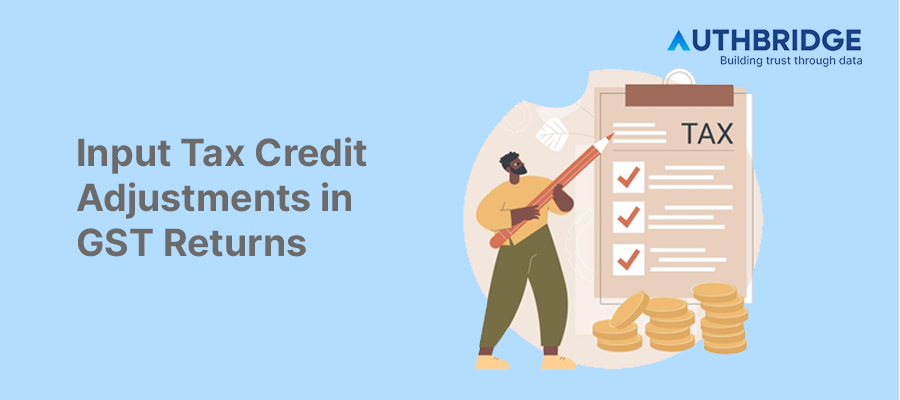ITC Adjustments: A Guide To Accurate GST Return Filing

1. Introduction to Input Tax Credit (ITC) in GST
Concept and Importance
Input Tax Credit (ITC) is a mechanism in the GST framework that allows taxpayers to claim credit for the tax paid on purchases. This credit can be used to offset the GST liability on sales, effectively ensuring that tax is paid only on the value addition. The ITC mechanism avoids the cascading effect of taxes and is a cornerstone of the GST regime, promoting business efficiency and reducing the overall tax burden.
Eligibility Criteria for Claiming ITC
To claim ITC, taxpayers must meet certain conditions:
- Possession of a valid tax invoice or debit note.
- Receipt of goods or services.
- The supplier has paid the corresponding tax to the government.
- The recipient has filed the GST returns (GSTR-1 and GSTR-3B).
2. Conditions for Availing ITC
Valid Tax Invoice
A valid tax invoice is the primary document for availing of ITC. It must contain details like GSTIN of the supplier and recipient, description of goods or services, tax charged, and other mandatory fields as prescribed under GST law.
Receipt of Goods or Services
ITC can only be claimed upon the receipt of goods or services. In cases of partial delivery, ITC can be availed proportionately.
Payment of Tax to the Government
The supplier must have paid the collected tax to the government for the recipient to avail of the ITC on those supplies.
Filing of GST Returns
The recipient must file the necessary GST returns, primarily GSTR-3B, to claim the ITC. The details of ITC claimed are reported in this return and are subject to reconciliation with GSTR-2A/2B.
3. Reconciliation of ITC
Matching ITC with GSTR-2A/2B
Reconciliation involves matching the ITC claimed by the recipient in GSTR-3B with the details furnished by the suppliers in GSTR-1, which auto-populates in GSTR-2A/2B. This process ensures that ITC claims are accurate and substantiated by supplier declarations.
Importance of Timely Reconciliation
Timely reconciliation helps in identifying discrepancies early and taking corrective actions, such as following up with suppliers to rectify missing or incorrect filings. This minimizes the risk of ITC reversals or penalties due to non-compliance.
4. Adjustment of ITC in GST Returns
Procedure for Adjusting Excess or Less ITC
Adjustments for excess or less ITC claimed need to be made in subsequent GST returns. If excess ITC has been claimed, it should be reversed, and additional tax liability should be paid. Conversely, if less ITC has been claimed, the additional amount can be availed in the returns of subsequent months.
Documentation and Record-Keeping
Maintaining proper documentation, such as invoices, debit notes, and reconciliation reports, is crucial for supporting ITC claims and adjustments. These records should be readily available for verification during audits or assessments.
5. Common Issues and Resolutions
Mismatch in ITC Claims
Discrepancies between ITC claimed in GSTR-3B and the credits available as per GSTR-2A/2B are common issues. Regular reconciliation and communication with suppliers to correct their filings are essential steps in resolving mismatches.
Rectification of Errors in Subsequent Returns
Errors identified in ITC claims must be rectified in subsequent GST returns. The GST portal allows for such adjustments, ensuring that the overall ITC availed matches the eligible credits as per invoices and compliance requirements.
6. Reporting in Annual Returns (GSTR-9)
Disclosure of ITC Adjustments
In the annual return (GSTR-9), taxpayers must disclose any adjustments made to ITC during the financial year. This includes details of ITC availed, reversed, and ineligible credits.
Impact on Financial Statements
ITC adjustments have a direct impact on the tax liability and, consequently, the financial statements of the taxpayer. Accurate reporting and reconciliation of ITC ensure compliance and reflect the true financial position of the business.
By adhering to the guidelines and best practices for ITC adjustments in GST returns, taxpayers can ensure compliance, optimize their tax liabilities, and maintain a healthy cash flow.
Category

Abhinandan Banerjee
(Associate Manager - Marketing)
Abhinandan is a dynamic Product and Content Marketer, boasting over seven years of experience in crafting impactful marketing strategies across diverse environments. Known for his strategic insights, he propels digital growth and boosts brand visibility by transforming complex ideas into compelling content that inspires action.



